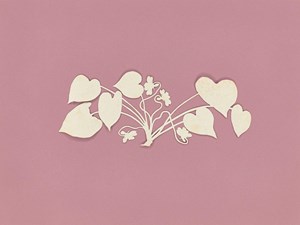
At this year’s Grisebach summer auction in Berlin, some outstanding pieces were acquired for the Kupferstich-Kabinett, part of Staatliche Kunstsammlungen Dresden (SKD), thanks to the generous support of several sponsors.
A group of eleven cut-paper works by the famous North German Romanticist Philipp Otto Runge (1777–1810) were purchased with the help of substantial funding from Ernst von Siemens Kunststiftung, HERMANN REEMTSMA STIFTUNG, Rudolf-August Oetker-Stiftung (supporting art, culture, science and the conservation of monuments), the friends association Verein der Freunde des Kupferstich-Kabinetts Dresden e. V. and private sponsors, alongside the SKD’s own funds. Runge gave the pieces to the family of Johannes Michael Speckter (1764–1845), close friends of his who played an important role in the Hamburg art scene at that time.
At the auction, a collection of works came up for sale belonging to the brothers Erwin and Otto Speckter and their artist friends. Preserved unopened in the estate of a branch of the Speckter family, the papercuts had been kept just as they were when Runge presented his gift: whereas most other works were later glued in position, these remained loose, placed between sheets of cardboard. Their “mobility” brings out the vitality of these little paper pictures even more effectively.
This acquisition plugs a yawning gap in the collection. Though Runge’s works are of great significance to Dresden Romanticism, few were previously found in the SKD’s holdings. All the Kupferstich-Kabinett held until now was a small self-portrait from the collection by Carl Christian Vogel von Vogelstein, and “Times of Day”, a cycle of drawings that sum up the principles of the artist’s entire oeuvre, and in which his understanding of landscape art is expressed in ornamental depictions of plants.
Runge came from Wolgast, in the north-east German state of Mecklenburg-Western Pomerania, and lived in Dresden from 1801 to 1804: a short time, but one with a formative impact on his artistic development. It was then that he became acquainted with the writer Ludwig Tieck and the natural philosopher Heinrich Steffens, and began the dialogue with Johann Wolfgang von Goethe that would shape his future work. Having already met Caspar David Friedrich in Greifswald, Runge was able to build on that important encounter in Dresden. Runge’s understanding of the landscape is an independent counterpart to that of Friedrich.
Runge’s cut-paper works can also be described as fundamental to his thoughts on the nature of pictures. The artist explores the beauty of plants in their many forms while also tracing their architecture; the organic laws according to which they were formed. Based on precise observations of nature, the papercut imposes a process of abstraction on their natural shapes. Runge’s works transform plants from a basic element of nature into an allegory revealing the divine plan of creation.
Runge was first taught the art of papercutting at the age of eleven, by his older sister. The contemporary fashion for silhouettes had developed into a popular pastime to fill the hours. Runge became extremely skilled in the technique, which he practised throughout his artistic career. He is often quoted as wishing that he could work as easily with a paintbrush and pencil as he could with the scissors, which, he said, felt like an “extension of his fingers”. Thus, many of these little decorative works of art came about. Many told stories, many were portraits; most were flowers, given to his family and friends as gifts.
Image : © Kupferstich-Kabinett, Staatliche Kunstsammlungen Dresden, Foto: Grisebach GmbH

ArtDependence Magazine is an international magazine covering all spheres of contemporary art, as well as modern and classical art.
ArtDependence features the latest art news, highlighting interviews with today’s most influential artists, galleries, curators, collectors, fair directors and individuals at the axis of the arts.
The magazine also covers series of articles and reviews on critical art events, new publications and other foremost happenings in the art world.
If you would like to submit events or editorial content to ArtDependence Magazine, please feel free to reach the magazine via the contact page.